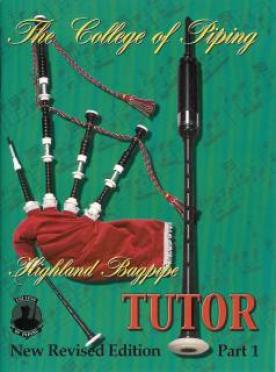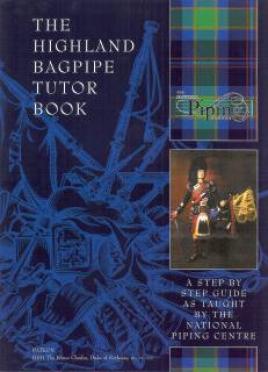Learning the bagpipes requires:
-A good quality practice chanter
-Tutor Book (often comes with audio CD)
-Formal lessons with a teacher
Practice Chanter:
-Is an instrument in its own right
-Primary purpose is to learn fingering for the bagpipe chanter
-Will always be used. Even a skilled piper learns new tunes and fingering on a practice chanter
 -Can be used to practice when a full set of pipes is impractical
-Can be used to practice when a full set of pipes is impractical
Difference between a Bagpipe Chanter and a Practice Chanter:
Bagpipe Chanter:
- has a large tapered bore and a cane reed
- produces a louder sound
- requires a large volume of air and substantial pressure
- not suitable for practice (on its own)
Practice Chanter:
- has a narrower cylindrical bore and a plastic reed
- quieter sound
- requires less air and lower pressure which allows longer practice sessions
- pitched one octave lower than a bagpipe chanter
The practice chanter consists of three parts:
1) The Practice Chanter Body - looks like a bagpipe chanter with general size and finger hole location, but a narrow bore which lowers the pitch (one octave) and volume.
2) A Reed - usually made from a plastic, ensures stable pitch despite wet blowing.
3) A Practice Chanter Top/Mouthpiece - A tube and air chamber that surrounds and protects the reed and allows the player to blow into the instrument. It is long enough to place the practice chanter and your hands in a comfortable position.
Options available for Practice Chanters and Cost of Average Practice Chanter:
·Size - the size of the chanter will depend on the age of the student. Young children with small hands will not be able to reach the required finger spacing on a full sized practice chanter, but can still learn the basic fingering on a smaller chanter. Once your hands are big enough for a long chanter (same finger spacing as a pipe chanter), you should practice with a long chanter because the fingering is easily transferred to the pipe chanter.
o Child- generally because of their small hands, children are unable to reach the pinkie finger hole and maintain proper finger position on a long practice chanter. The holes on a child's practice chanter are closer together, and the overall length is shorter to accommodate a shorter stature.
o Regular- most commonly for youth pipers or pipers with smaller hands. The holes are very similar to that of a bagpipe chanter.
o Long- typically recommended for adults. The finger hole positions are identical to that of a bagpipe chanter.
· Material - practice chanters are made of wood, plastic or both.
o Wood offers high quality sound. Even quality wood practice chanters are prone to cracking from moisture.
o Practice chanters made with a combination plastic mouthpiece top on a wooden chanter body help with problem.
o Quality plastic chanters are durable, with good tone.
· Make/Style - some practice chanters offer counter-sunk finger holes. This makes it easier to feel where the holes are. The holes also feel larger which is much similar to the finger holes on a bagpipe chanter. Some manufacturer's chanters are quieter than others. Some makers, such as Walsh, offer water traps.
· Cost -Wood practice chanters range from about $300 to $500 (depending on mounts), Plastic practice chanters cost $65 to $150 (depending on mounts). The combination wood/plastic practice chanters are $245 with engraving.
Tutor Books:
Your instructor will likely have a tutor book they prefer to teach from. If you are trying to teach yourself, here are a few good options:
· "Green Book" the College of Piping Volume 1 *Note: As of 2019, this book is now called the Highland Bagpipe Tutor and has a new cover.
o A good tutor book to start with as it begins with the very basics, assuming no prior knowledge or musical experience by the student. This allows the student to start in on it alone.
o Structured so that the student piper can learn one lesson a week, making a complete course of just over six months.
o Explains all of the required first movements and gives the student maximum benefit. A link is provided to corresponding videos
· National Piping Centre Tutor Book
o Also very rudimentary information, a very good resource for someone who wants to learn on their own.
o Includes a CDROM with step-by-step guide to supplement book
o Includes an appendix that talks about the bagpipe in comparison to
other instruments for those individuals who have previous musical knowledge.
· John Cairns Bagpipe Solutions
o 7 highly detailed volumes are available from world class piper, John Cairns (the first 3 cover the practice chanter)
o Each volume is accompanied by a CD
o Contains in-depth material on all aspects of piping - including theory, maintenance, tone, tuning, band and instrument drill, technical playing, reading music (time and rhythm), the wearing of highland dress, music instructional training, bagpipe history and ear training.
**These are the tutor books that are our most popular/common. There are many other quality tutor books available.
Formal Lessons with a Teacher
Evaluating your Instructor:
· Consider your goals and find an instructor teaching competitively, for fun, or piobaireachd (pronounced "pee brock", which is the classical music of the bagpipes). Depending on what your goals are, your instructor's methods may or may not be a good fit.
· Inquire what grade level your potential instructor is (or was); if he/she has ever competed.
· How long he/she has been piping
· How long he/she has been teaching
· How many students he/she currently has, and if he/she can provide you a list of references of his/her students for you to contact.
· Cost
There are also some instructors that offer courses and top quality training online. Ken Eller of Captain's Corner, for example, offers online instruction using a chat room type setting with video conferencing. This may be an option if there is no instructor within driving distance.
Where to look for an Instructor:
· Pipe band - an obvious place to find an instructor. Some pipe bands may even give free instruction.
· Bagpipe Association - may have a list of instructors in their area, however not all instructors may belong to the association and may not be on the list as a result. Associations can also help you find a pipe band that may be close.
· Highland Games - a Scottish festival or highland games is a fantastic place to pick up piping contacts.
· Musical instrument retailer - although not all retailers sell pipes or piping supplies, most do have some knowledge of the local music scene and should be able to refer you to someone.
· Piping supplier - they deal with pipers on a regular basis and will most likely know an instructor or band to which they can refer you.
· Scottish/Celtic Goods Store - owners of stores that sell Scottish trinkets, clothes, etc. usually know bagpipers in the area.
· Search engine - key terms like "piping instructor", "bagpipe teacher", "piping teacher", and "bagpipe instructor" are good to plug into search engines. Just make sure that you have your city/town along with it to ensure that you get local results.
Why you should get an instructor
· It is strongly recommended that you find an instructor, bagpipes are a complicated wind instrument
· Bad posture, poor fingering techniques, and poor tuning can be easily corrected with an instructor but difficult to learn after poor habits set in.
Your email address will not be published. Required fields are marked *

October 2425, 2013 at 05:32 pm
I've found putting my prcitace chanter in a drawer and leaving it there is one of the best things I've ever done for my piping. I learn all my tunes on pipes. I think this is something more people should endeavor to do. While it may take some a bit of getting used to it will pay off in the end.At the end of each season I learn 4 piobaireachds. This once took a considerable amount of time away from pipes. Often two or three months depending on the pieces. When it came time to put the tunes on pipes I ended up being full of biterness because I wasn't able to do what I could on the prcitace chanter. My left hand wasn't able to produce clean gracing because it wasn't used to the pressure exerted from the bag. After a few weeks of regular prcitace I would finally start to see progress and become happy with what was starting to happen. This transitional period was always a very difficult time of year to keep focus and stay positive. It let a self defeating attitude creep in and either ruin or cut short valuable prcitace time. By learning my tunes on pipes I've eliminated my least favorite part of playing. It's also added anywhere from 120-180 hours of time on pipes I wouldn't be getting had I not abandoned something that wasn't helping my playing. Now the only time I play my prcitace chanter my lesson night every two weeks. I find it foreign and rejoice when I return it to it's new home at the bottom of a drawer.
Reply
Copyright © 2002-2024 Kinnaird Bagpipes & Reeds. All Rights Reserved
Design & Development by2 Web Design